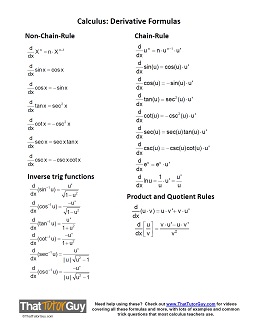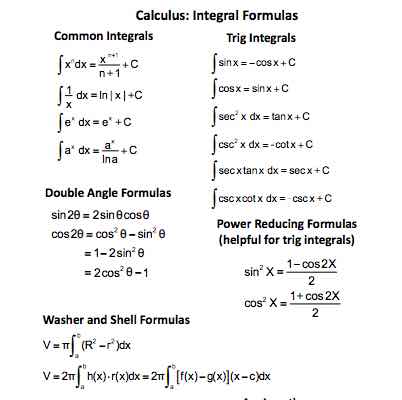Making Calculus fun tolerable
Chris is a Stanford-educated tutor with over 10 years experience tutoring Calculus to students of all abilities, from students struggling to get from a C to a B, to go-getters trying to move an A- up to an A, to struggling students just hoping to pass. In that time he got a lot of experience learning how to explain this stuff in a way it actually makes sense to non-math people. Through his videos he has helped countless students, and he can do the same for you.
Calculus
Whether you're in high school or college, AP or regular, AB or BC, "Calculus for Business" or "Calculus for Science & Engineering," calculus classes always cover basically the same topics, in the same order. The only difference comes in whether certain topics are skipped and how hard the problems are. So no matter what school you're in, if you're in calculus, this page is for you!We sometimes get the question of where Calc 1 ends and Calc 2 begins... It's different by school, but since everyone goes in roughly the same order, just look for where your class is now. |
|
-
I. Limits & Continuity:
The videos in this chapter cover the more conceptual side of limits. In the first video we cover what limits are, and give an overview of the various types of limit problems you'll see in calculus. The rest of the videos cover analyzing graphs for limits, figuring out if the limit "exists", and finding the limits of piecewise functions.
If your teacher covers this, you'll know it! Very painful way to start off limits.
This chapter covers how to figure out if a function is continuous from both a graphical and limit perspective, including the definition of continuous.
One-sided limits are the ones where you're approaching x from either the right or the left. 3+ means limit approaching 3 from the right, 3- means approaching 3 from the left.
These are your classic "big mess of algebra" limit problems, which happen when a limit is "indeteriminate" (plugging in results in 0/0 or infinity/infinity). This chapter covers finding limits of "giant fractions" (i.e. rational expressions) containing polynomials and roots & radicals.
This chapter covers what to do when X is approaching infinity (the sideways 8 symbol), as well as how we can use this new skill to find horizontal asymptotes of rational functions.
You'll recognize these when you see them. They'll give you the limit of f & g (but not the equations themselves) and make you combine them. Sort of like log rules, if you're into that.
If a limit has a sine or cosine, this chapter covers it. Besides knowing your unit circle so you can plug in, this chapter has a couple special formulas and strategies. Also covered are special limits like sinx/x and cosx/x.
These nasty puppies are limit problems with a sine or cosine which has an X in the denominator of the "argument", like sin(1/x) or cos(pi/x).
A theorem that's in the top five of most useless things you'll learn (or not) in calculus. Very little use, unless your teacher tells you it's on the test.
These videos introduce the limit definition of derivatives, which every class covers and then forgets about. It's the one where you have to find f(x+h), then somehow plug in h and take the limit as h approaches zero.
This shortcut for finding limits is easier than everything that's come before, but it requires taking derivatives.
-
II. Derivatives
A tangent line is the equation of a line that's tangent to a function at a particular point, and you find it by using derivatives. This line is important because it's slope is the "rate of change" of the function at that point. Just to make things awesome, we'll also review point-slope form of lines since that's the easiest way to find a tangent line.
This chapter covers the formulas for taking the derivatives of exponents, polynomials, powers of x, trig functions (sin, cos, tan, cot, sec, csc), exponentials, and radicals. As long as you don't need chain rule.
The basics of the product and quotient rules, but without the chain rule. There's a similar chapter covering these formulas with the chain rule later.
Using The Chain Rule to take derivatives of:
Power Rule
Roots & Radicals
Trig Functions
Inverse Trig Functions
Exponentials
Logs
In this lengthy chapter we'll re-learn all the derivative formulas, except this time using the Chain Rule too: exponents (power rule), roots & radicals, trig functions, inverse trig functions, exponentials, and natural logs. A must-watch for Calculus students!
This chapter brings the chain rule to product and quotient derivatives. If you haven't, check out the first product & quotient rule chapter first.
In this chapter we'll cover the basics of taking derivatives implicitly (finding y'), using them to find equations of tangent lines, and finding second derivatives (y'').
Derivative word problems involving rates of change in area, volume, etc. All derivatives taken with respect to time.
Mean Value & Rolle's Theorem
Instantaneous Rate of Change
Average Rate of Change
In this chapter we cover these two straightforward (but basically useless) problem types that every teacher seems to ask.
This chapter is a grab bag of graphical analysis. Intervals of increase and decrease, how to find critical values, how to sketch the derivative of a function just from the sketch of the original function, and a general intro to relative extrema (maxima and minima).
Extrema (maximums and minimums) come in two flavors: relative and absolute. This chapter covers both, and how to find them using the first derivative test.
The "other" derivative word problems (related rates are the big one), where you maximize or minimize the area, volume, or cost of some quantity.
This chapter introduces concavity, points of inflection and the second derivative test, then reviews asymptotes, relative extrema, and how to find intercepts so you'll have the tools for graphing functions calculus-style.
Unique Derivatives
Logarithmic Differntiation aka Derivatives with Variables In Both Exponent & Base
The videos in this chapter cover specific and unusual types of derivatives that I wasn't sure where else to put, such as: xx and (sinX)x.
Using the equation of the tangent line to approximate values of functions.
Slope fields and Euler's Method are actually pretty similar, so the videos in this chapter explain how to manage both.
A plug-and-chug chart for approximating the zeros (a.k.a. roots, intercepts, solutions) of a function.
This chapter covers solving differential equations using integration: separation of variables, initial conditions, general solutions, specific solutions.
The video in this chapter explains the basics of partial derivatives, how to find them, their notation, and how to tell if a function is continuous based on its partial derivatives.
-
III. Integrals & Anti-Derivatives
Basic integration (antiderivatives) of power rule polynomials, roots & radicals, trig functions, and initial value problems, all WITHOUT u-substitution.
In this chapter we'll approximate area using left-hand sums, right-hand sums, midpoint, upper bounds, lower bounds, and trapezoidal rules. Collectively, these are called "Riemann Sums" or "approximation integration".
In this chapter we use The Fundamental Theorem of Calculus and definite integrals (the ones with little numbers on the integral sign) to find the area under curves, negative area, and integral properties.
U-Substitution Integration:
Power Rule & Exponents
Roots & Radicals
Trig Functions
Exponentials
LogsThis chapter covers U-substitution with all the major integral types: power rule, roots, radicals, rational functions, fractions, exponentials, logs, trig functions.
Finding the average value of a function on an interval, word problems, plug-and-chug.
Both first and second fundamental theorems.
Using dx and dy integrals to find the area between functions
Volume: the hardest topic in calculus. Four hours of videos get you through the integral disk method, washer method, and shell method.
Using the equation of the tangent line to approximate values of functions.
-
IV. Advanced Integration Techniques
From easy to hard, this formula allows us to use u, v, du and dv to integrate the products of functions multiplied together.
Also called "trig sub", a method for solving integrals with square roots in them by substituting a trig function for x.
The power reducing formula for sine and cosine, as well as how to integrate powers of sine, cosine, tangent, co-tangent, secant, co-secant.
This chapter reviews partial fraction decomposition (in case you're rusty), then goes through how to use the technique to integrate some nasty rational functions.
Integrals where infinity is one of your limits of integration, or the function doesn't exist at one of the limits.
Using integration to find arc length of a function, or surface area of a revolved surface, on an interval.
This chapter covers solving differential equations using integration: separation of variables, initial conditions, general solutions, specific solutions.
This chapter covers converting parametric equations to rectangular and back again, eliminating the parameter, parametric forms of circles and ellipses, and graphing them.
V. Business Calculus
These videos cover a few topics that are taught in Business Calculus and Economics, which also show up sometimes in regular calculus classes. Marginal cost, marginal revenue, and marginal profit. The Demand Function, which gives you the demand (x) based on price (p). Overall, these topics allow you to calculate and maximize the profit of a business.
-
VI. Physics Applications of Calculus
Work by a constant or variable force: gravity, expanding gas, friction, efficiency, power. Also fun explanations of what the heck work is, and how to figure out what these problems are even asking!
The first two videos in this chapter cover finding center of mass of one-dimensional and two-dimensional (2-D) systems without using calculus, then the final video covers using integrals.
This chapter covers the basics of pressure and the forces that pressure can exert on a surface, then it gets into using integrals to find the pressure on a vertical surface (plate, window, etc.).
Basics of vector addition, subtraction, multiplication, dot product, scalar product, magnitude, unit vectors, cross multiplication, and components.
This chapter covers kinematics projectile motion problems as you would see in Pre-Calculus or Algebra 2 math classes. This topic is covered in more depth on the physics page. One-dimensional and two-dimensional gravity problems, range, vector components of velocity, etc.
-
VII. Series
Common confusion: a "series" is just a sequence with plus signs between the terms instead of commas. All other questions, check out the chapter page, which includes a free printable pdf of all the formulas for arithmetic and geometric sequences.
Everything you could possibly need to know about convergence and divergence of infinite series is all in this one chapter because otherwise it would be really confusing. In addition to the topics listed to the left, there's a free overview of series convergence, as well as more obscure topics like the remainder (error) of an alternating series approximation.
This chapter covers non-linear approximation of functions, and the series expansions which make them possible.
This chapter covers radius of convergence and intervals of convergence for power series, which are just the generic name for infinite series like Taylor and Maclaurin.

